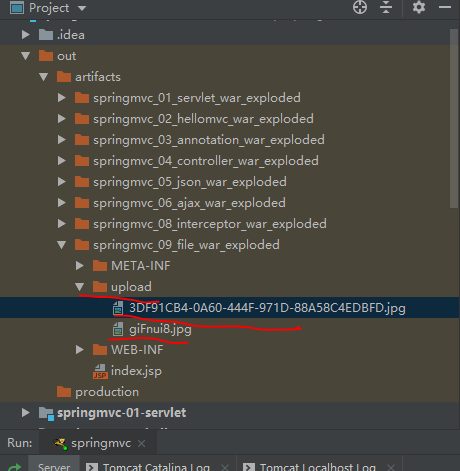转载:https://blog.kuangstudy.com/index.php/archives/486/
一.SpringMVC文件上传和下载
1.准备
文件上传是项目开发中最常见的功能之一 ,springMVC 可以很好的支持文件上传,但是SpringMVC上下文中默认没有装配MultipartResolver,因此默认情况下其不能处理文件上传工作。如果想使用Spring的文件上传功能,则需要在上下文中配置MultipartResolver。
前端表单要求:为了能上传文件,必须将表单的method设置为POST,并将enctype设置为multipart/form-data。只有在这样的情况下,浏览器才会把用户选择的文件以二进制数据发送给服务器;
对表单中的 enctype 属性做个详细的说明:
-
application/x-www=form-urlencoded:默认方式,只处理表单域中的 value 属性值,采用这种编码方式的表单会将表单域中的值处理成 URL 编码方式。
-
multipart/form-data:这种编码方式会以二进制流的方式来处理表单数据,这种编码方式会把文件域指定文件的内容也封装到请求参数中,不会对字符编码。
-
text/plain:除了把空格转换为 "+" 号外,其他字符都不做编码处理,这种方式适用直接通过表单发送邮件。
<form action="" enctype="multipart/form-data" method="post">
<input type="file" name="file"/>
<input type="submit">
</form>
一旦设置了enctype为multipart/form-data,浏览器即会采用二进制流的方式来处理表单数据,而对于文件上传的处理则涉及在服务器端解析原始的HTTP响应。在2003年,Apache Software Foundation发布了开源的Commons FileUpload组件,其很快成为Servlet/JSP程序员上传文件的最佳选择。
-
Servlet3.0规范已经提供方法来处理文件上传,但这种上传需要在Servlet中完成。
-
而Spring MVC则提供了更简单的封装。
-
Spring MVC为文件上传提供了直接的支持,这种支持是用即插即用的MultipartResolver实现的。
-
Spring MVC使用Apache Commons FileUpload技术实现了一个MultipartResolver实现类:CommonsMultipartResolver。因此,==SpringMVC的文件上传还需要依赖Apache Commons FileUpload的组件==。
2.文件上传的两种代码
步骤:
-
在pom.xml中添加jar包
-
配置springmvc-servlet.xml
-
编写前端页面
-
编写后端控制器
-
测试
(1)代码一:
在pom.xml中添加jar包
<!--文件上传-->
<dependency>
<groupId>commons-fileupload</groupId>
<artifactId>commons-fileupload</artifactId>
<version>1.3.3</version>
</dependency>
<!--servlet-api导入高版本的-->
<dependency>
<groupId>javax.servlet</groupId>
<artifactId>javax.servlet-api</artifactId>
<version>4.0.1</version>
</dependency>
配置springmvc-servlet.xml
<!--文件上传配置-->
<bean id="multipartResolver" class="org.springframework.web.multipart.commons.CommonsMultipartResolver">
<!-- 请求的编码格式,必须和jSP的pageEncoding属性一致,以便正确读取表单的内容,默认为ISO-8859-1 -->
<property name="defaultEncoding" value="utf-8"/>
<!-- 上传文件大小上限,单位为字节(10485760=10M) -->
<property name="maxUploadSize" value="10485760"/>
<property name="maxInMemorySize" value="40960"/>
</bean>
编写前端页面
<%@ page contentType="text/html;charset=UTF-8" language="java" %>
<html>
<head>
<title>upload</title>
</head>
<body>
<h1>方式1</h1>
<form action="${pageContext.request.contextPath}/upload" enctype="multipart/form-data" method="post">
<input type="file" name="file"/>
<input type="submit" value="upload">
</form>
</body>
</html>
编写后端控制器
import org.springframework.web.bind.annotation.RequestMapping; import org.springframework.web.bind.annotation.RequestParam; import org.springframework.web.bind.annotation.RestController; import org.springframework.web.multipart.commons.CommonsMultipartFile; import javax.servlet.http.HttpServletRequest; import java.io.*; @RestController public class FileController { //@RequestParam("file") 将name=file控件得到的文件封装成CommonsMultipartFile 对象 //批量上传CommonsMultipartFile则为数组即可 @RequestMapping("/upload") public String fileUpload(@RequestParam("file") CommonsMultipartFile file , HttpServletRequest request) throws IOException { //获取文件名 : file.getOriginalFilename(); String uploadFileName = file.getOriginalFilename(); //如果文件名为空,直接回到首页! if ("".equals(uploadFileName)){ return "文件名为空!!"; } System.out.println("上传文件名 : "+uploadFileName); //上传路径保存设置 String path = request.getServletContext().getRealPath("/upload"); //如果路径不存在,创建一个 File realPath = new File(path); if (!realPath.exists()){ realPath.mkdir(); } System.out.println("上传文件保存地址:"+realPath); InputStream is = file.getInputStream(); //文件输入流 OutputStream os = new FileOutputStream(new File(realPath,uploadFileName)); //文件输出流 //读取写出 int len=0; byte[] buffer = new byte[1024]; while ((len=is.read(buffer))!=-1){ os.write(buffer,0,len); os.flush(); } os.close(); is.close(); return "上传成功!!"; } }
测试成功!

(1)代码二:
采用file.Transto 来保存上传的文件
编写前端页面
<h1>采用file.Transto 来保存上传的文件</h1>
<form action="${pageContext.request.contextPath}/upload2" enctype="multipart/form-data" method="post">
<input type="file" name="file"/>
<input type="submit" value="upload">
</form>
编写后端控制器
/* * 采用file.Transto 来保存上传的文件 */ @RequestMapping("/upload2") public String fileUpload2(@RequestParam("file") CommonsMultipartFile file, HttpServletRequest request) throws IOException { //上传路径保存设置 String path = request.getServletContext().getRealPath("/upload"); File realPath = new File(path); if (!realPath.exists()){ realPath.mkdir(); } //上传文件地址 System.out.println("上传文件保存地址:"+realPath); //通过CommonsMultipartFile的方法直接写文件(注意这个时候) file.transferTo(new File(realPath +"/"+ file.getOriginalFilename())); return "上传成功!!"; }
测试成功!
3.文件下载
文件下载步骤:
-
设置 response 响应头
-
读取文件 -- InputStream
-
写出文件 -- OutputStream
-
执行操作
-
关闭流 (先开后关)
编写前端页面
<a href="${pageContext.request.contextPath}/download">点击下载</a>
编写后端控制器
在项目打包目录下的upload文件夹中拿一张代码图片.png的图片下载下来
@RequestMapping(value="/download") public String downloads(HttpServletResponse response , HttpServletRequest request) throws Exception{ //要下载的图片地址 String path = request.getServletContext().getRealPath("/upload"); String fileName = "代码图片.png"; //1、设置response 响应头 response.reset(); //设置页面不缓存,清空buffer response.setCharacterEncoding("UTF-8"); //字符编码 response.setContentType("multipart/form-data"); //二进制传输数据 //设置响应头 response.setHeader("Content-Disposition", "attachment;fileName="+ URLEncoder.encode(fileName, "UTF-8")); File file = new File(path,fileName); //2、 读取文件--输入流 InputStream input=new FileInputStream(file); //3、 写出文件--输出流 OutputStream out = response.getOutputStream(); byte[] buff =new byte[1024]; int index=0; //4、执行 写出操作 while((index= input.read(buff))!= -1){ out.write(buff, 0, index); out.flush(); } out.close(); input.close(); return null; }